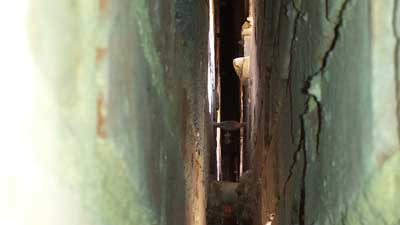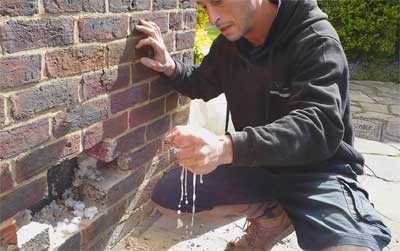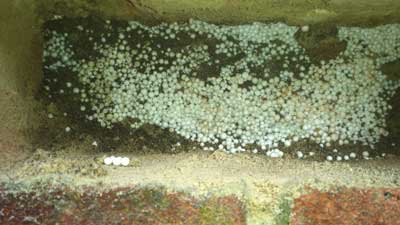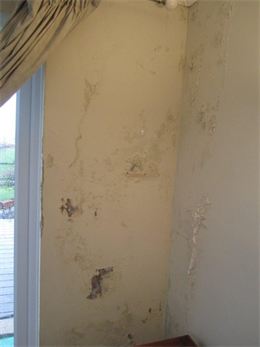Cavity wall insulation explained.
In theory cavity wall insulation is a great way to retain heat within your home and reduce energy consumption, which has been largely backed by the government.
Recently the government have pledged to put £2 billion pounds into energy saving measures for domestic dwellings which includes; cavity wall insulation, double glazing and boiler replacements. This is so that they can have a better chance of achieving the deadline of zero emissions by 2050 and the fact that by doing this, will create 1000’s of jobs in a much needed time. But in reality the problems many homeowners are now facing due to cavity wall insulation have far outweighed the benefits by a long shot.
What are the problems with Cavity wall insulation?
There are several types of cavity wall insulation offered, the most popular insulation presently is polystyrene beads (platinum beads) these are injected with a glue to bind the beads together.
The problems associated with this type of insulation are:
1. Over-bonding or under-bonding of the beads. Over-bonded beads can cause cracking to the external wall due to pressure and it will also allow water to pass through to the internal wall via the hardened glue. The only way currently to remove over-bonded beads is to completely remove the external wall and rebuild.
2. Under-bonded beads can allow ants to bring soil between the beads and create modernised nests, this in turn will cause dampness due to the soils ability to absorb moisture from the external wall. The other issue with under-bonded beads is that when any alterations are made to a house that requires removing bricks, a fast flow of beads will escape leaving your lovely lawn covered in tiny balls, and half the insulation now emptied out of the cavity.
The next type of insulation is Whitewool mineral fibre, this is made from slag rock or glass that’s broken down and spun into a fibre and then coated with a silicone to make it water resistant.
The problems associated with this type of insulation are:
1. Whitewool mineral fibre has been sold to homeowners as water resistant (not waterproof). Although some of the 1 day course surveyor/salesman of the insulation industry probably did sell it as a waterproof insulation just to get the sale. Whitewool mineral fibre is not waterproof and if a wall is exposed to long periods of heavy driving rain, there will be a very high chance of water penetration into your house.
2. Ants and other insects will again adopt residency amongst the insulation, potentially causing damp problems.
3. Whitewool mineral fibre is supposed to be injected under a certain pressure to ensure a full and correct density within the cavity, however due to the fact that the work is not seen by the homeowners, it gives opportunity to cowboy installers to pump the material under higher pressure and get the job done in half the time. The problem with this is that dense circles of whitewool will be present at the point of injection but elsewhere in the cavity it will have nothing. The problem with this is that these circles of dense insulation will certainly give you damp problems on a south or west facing wall at some point and you will also have a wall with varying temperatures, giving opportunity for condensation/mould to form on the uninsulated areas.
Urea formaldehyde foam insulation is another type that has previously been injected into cavity walls. Although it is no longer used, many homes have been insulated with the foam.
The problem with urea formaldehyde foam is:
1. When the foam comes into contact with moisture it disintegrates, while this seems great compared to the other types of insulation, it will then cause the wall to have varying temperatures, again resulting in the possibility of condensation/mould forming on the coldest areas.
So far to date, all retro fit cavity wall insulation materials have quite costly disadvantages. One common disadvantage that can arise from having any type of cavity wall insulation installed, is that by insulating the wall and loft spaces, you are creating a humid box that is filled with moisture created from living and breathing, with no means of escape unless you correctly heat and ventilate your home.
If you do not heat and ventilate your home properly when cavity wall insulation has been installed, mould growth will certainly occur on furniture, inside cupboards and in cold dead air spaces. The smaller the property size the greater the risk.
The last point to note before you have cavity wall insulation installed in your home is that despite being offered a 25 year guarantee backed by CIGA (cavity installers guarantee agency) if you have or need your cavity wall ties replaced, it may invalidate the guarantee. If your walls have slightly recessed joints or the rendering looks like it needs painting and you have damp caused by insulation, you will have a tough time in receiving any form of compensation, no matter how persistent.
Cavity wall insulation in the form of loose fill should be avoided.
You can insulate your property in other ways without causing a bridge between the inner and outer walls for water to transfer across.
If you insulate your property with any of the following methods, please remember that heating and ventilation is still required to reduce the risk of high humidity and mould growth within your home.
1. Insulated plasterboard is a great way to insulate your home if you are completely renovating inside, this is because all of the wall surfaces will be an even temperature with no cold areas left behind.
2. Exterior insulated render is ideal if your property is already rendered but will not work if you are in a listed property or conservation area.
3. Masonry water repellent cream is a slight help in saving energy due to the fact it will keep the external bricks dry and at a higher temperature than that of a wet brick. This can only be used on unpainted surfaces.




